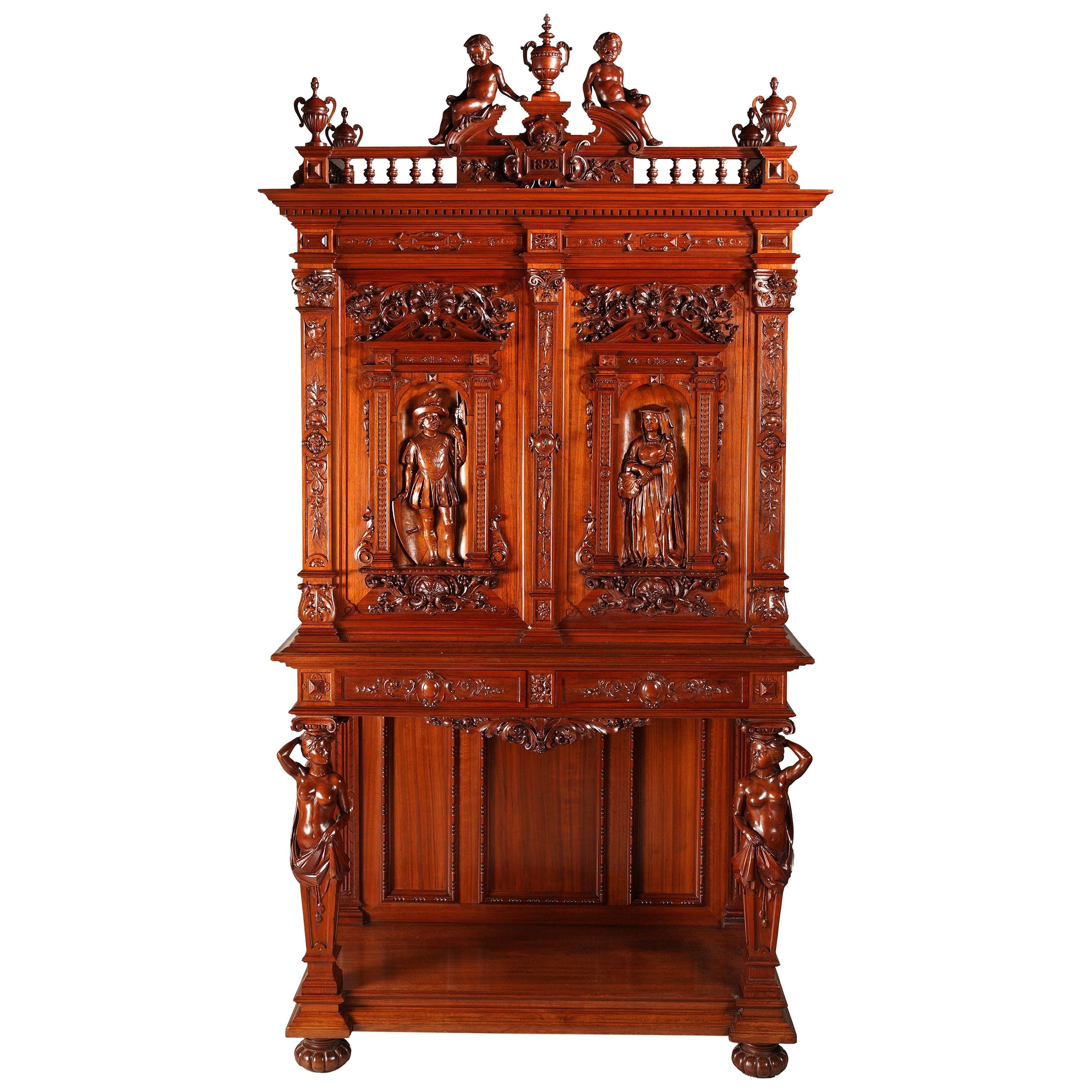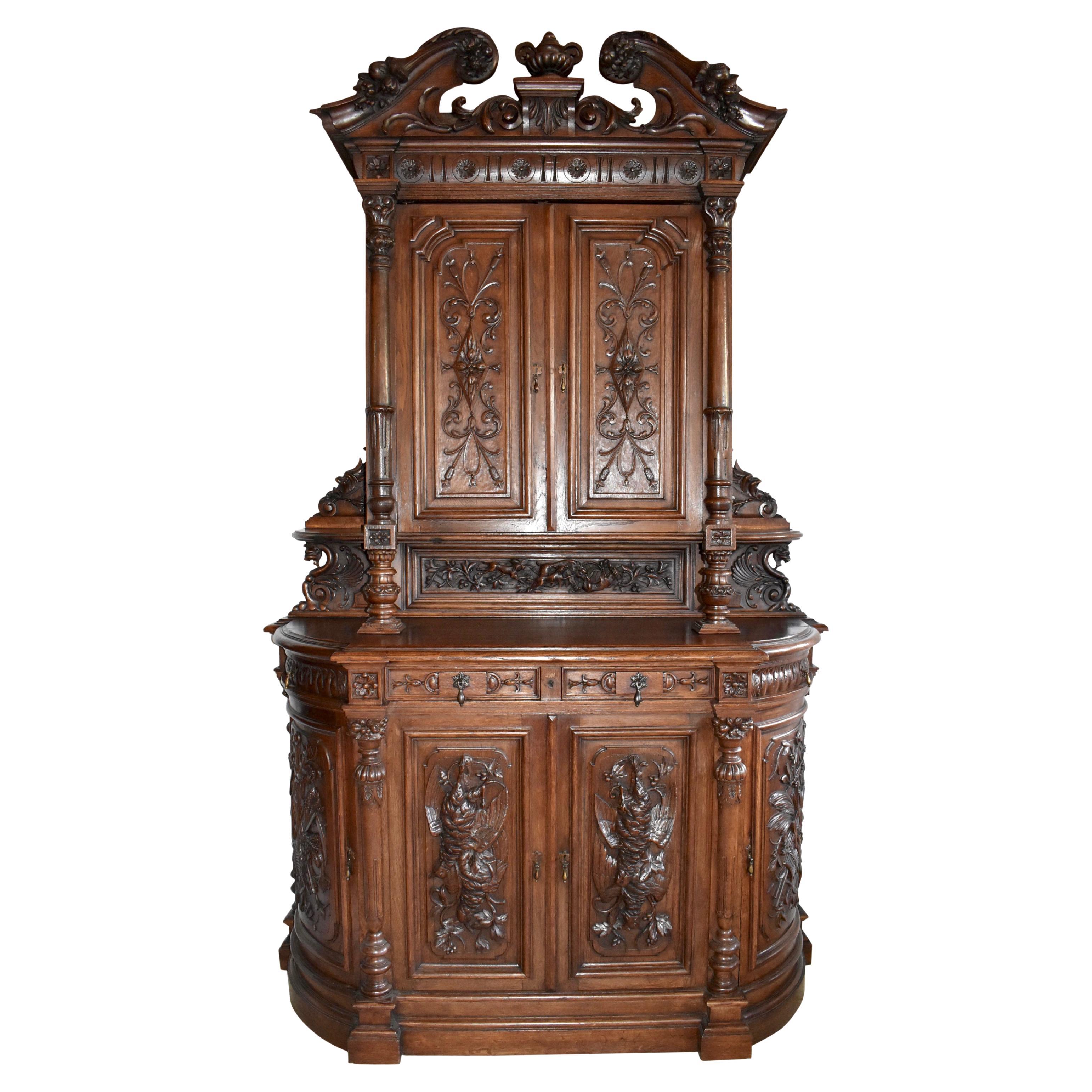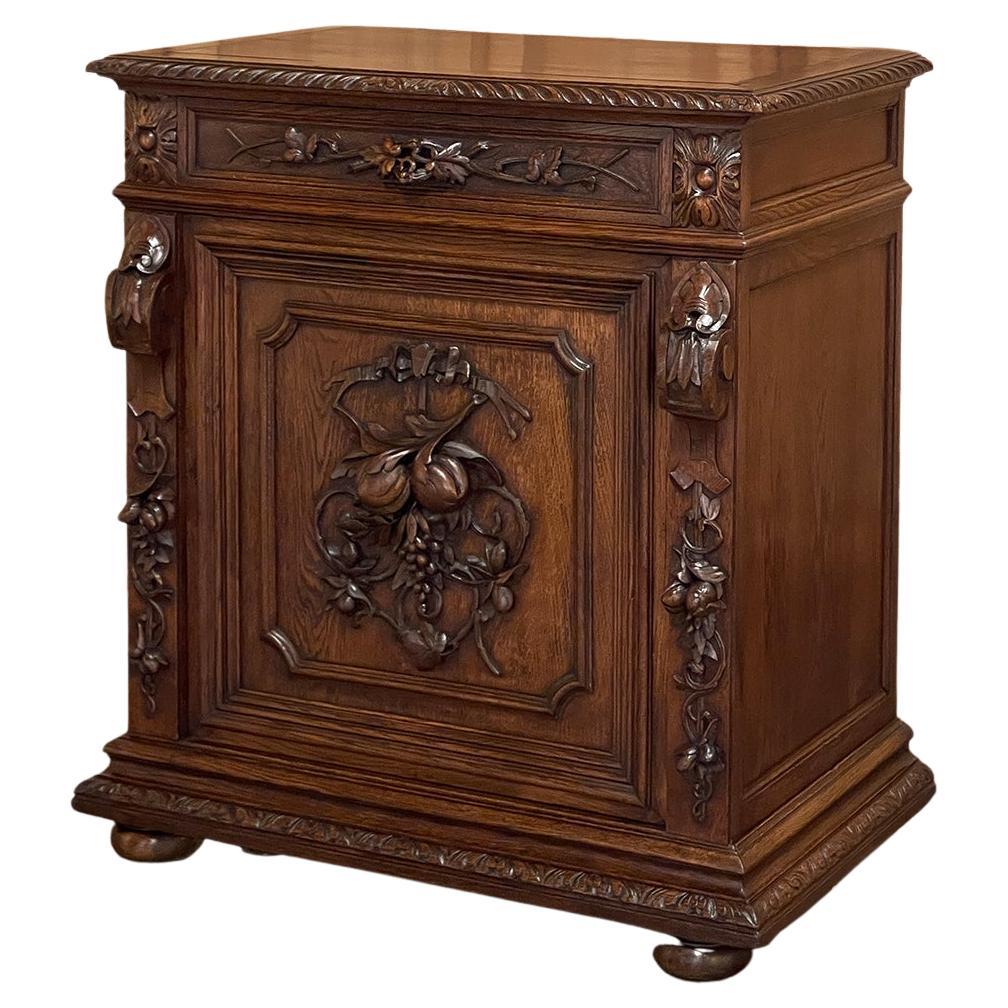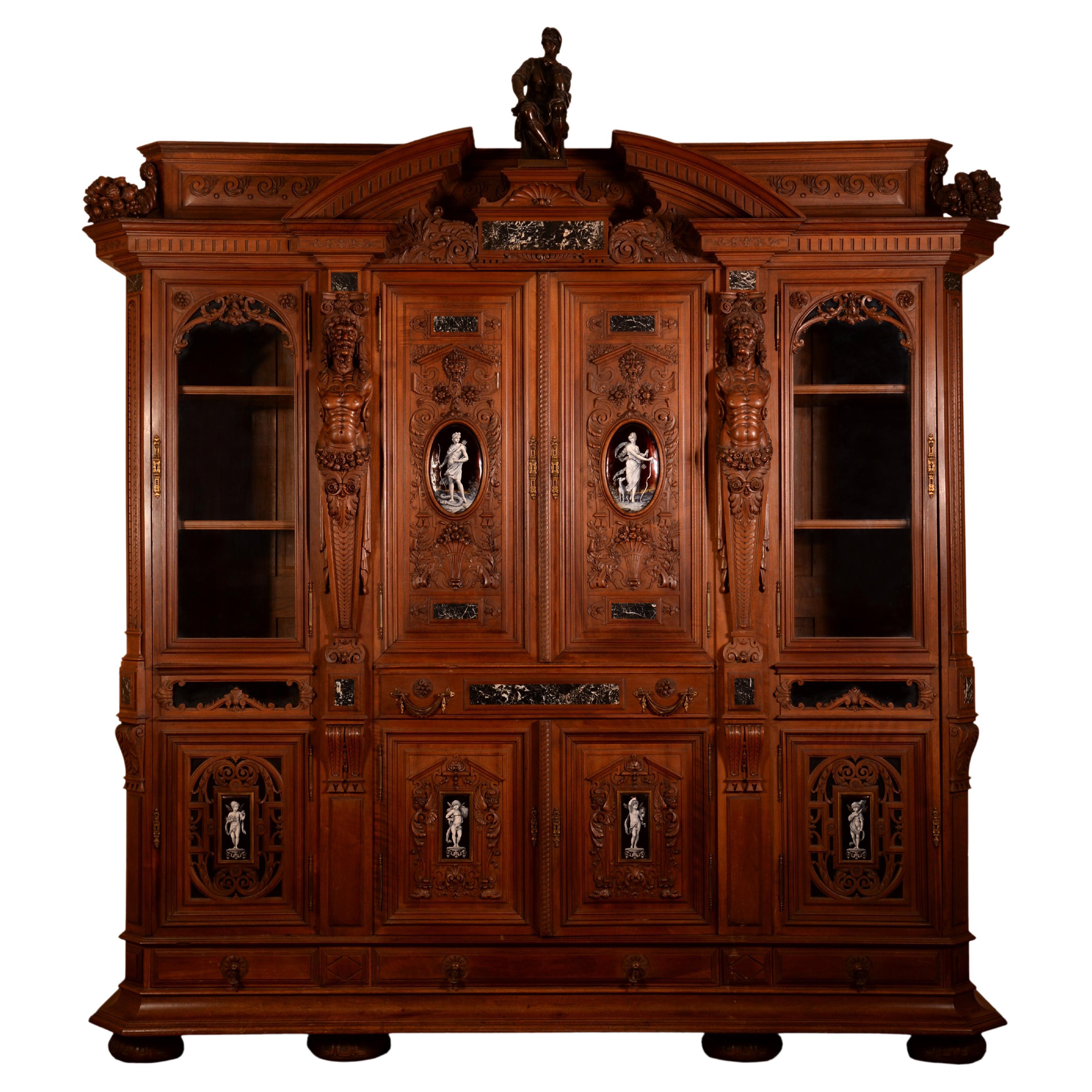Items Similar to Renaissance Style "Four Seasons" Cabinet by M. Lerolle, France, Circa 1890
Want more images or videos?
Request additional images or videos from the seller
1 of 20
Renaissance Style "Four Seasons" Cabinet by M. Lerolle, France, Circa 1890
About the Item
Signed " Meubles D’Art, M. Lerolle, Fabricant, 61, Rue des Sts-Peres. Paris "
Remarkable carved wood cabinet, richly sculpted in the Neo-Renaissance style, and inlaid with vert de mer marble cabochons and cartouches.
The upper part is formed by a scrolled broken pediment with a carved medallion supported by two putti at the centre. The facade features seven ionic columns adorned with ivy at their base and four female figures sculpted in the round, sheltered in niches and supported by cherub heads. The sculptures are allegories of the seasons. The upper part opens with three leaves and three drawers. In the lower part, the belt includes three drawers and is adorned with cartouches with mythological scenes. This piece of furniture is supported by two very richly sculpted winged sphinxes surrounding a central medallion adorned with a bacchanal scene, and stands on a moulded plinth and height feet.
This piece of furniture is a very fine example of the Neo-Renaissance style, which appeared in the years 1830 with Claude-Aimé Chenavard (ornemanist, 1798-1838), and was notably developed by the decorator Michel Liénard (1810-1870). This style followed the Neo-Gothic style and the cult of the Middle-Ages and succeeded on the long run. Inspiration sources were numerous in France and the iconographic richness of the mannerism flattered the taste of the Second Empire. Cabinet-markers notably took inspiration from the Henri II period and favored the use of richly sculpted solid and dark wood.
Our piece of furniture witnesses the interpretation and blending effort made by the artists of the nineteenth-century. It brings together the classicism of the Renaissance and its mythological subjects and the rigorous architectured structure, with a certain exuberance inherited from the Romanticism.
Related work :
Cabinet exhibited at the Exposition Universelle in 1867 (Fourdinois won a Grand Prix for his stand).
Museum of Decorative Arts, Paris (Inv. 29921).
Made by Henri-Auguste Fourdinois, Nivillier (ornaments design), Party (modelling of the bodies), Hugues Protat, Primo et Maigret (sculptures).
Illustrated in D. Ledoux-Lebard, Les Ebénistes du XIXe siècle, Ed. de l’Amateur, 1984, pp.205
Biography
The firm of Fourdinois, considered during the Second Empire as the greatest furniture manufacturer in Paris, was founded in 1835 by Alexandre-Georges Fourdinois (1799-1871). It was developed in the context of the Expositions Universelles. At the time, the firm already produces furniture of the Neo-Renaissance style, such as a dresser that won the Great Medal at the London Universal Exhibition of 1851. The son, Henri-Auguste Fourdinois (1830-1907), joined the firm in 1860 and will become head of the firm in 1867. The high quality of his designs was remarked at the Universal Exhibition in 1862, when the jury awarded him two medals « for Excellence of Composition and Execution ». Henri-Auguste, now sole in charge, brought the firm to the summit of its achievements at the 1867 Universal Exhibition in Paris by winning the Grand Prize for his stand. Apart from the commissions he executed for the « Mobilier de la Couronne », he also produced high quality furniture for the Parisian bourgeoisie. The firm is at its zenith during the years 1862-1880. At this time, it is considered as an example to follow for other cabinet-makers, whether they are French, British or American.
- Creator:Lerolle (Cabinetmaker)
- Similar to:Henri-Auguste Fourdinois (Cabinetmaker)
- Dimensions:Height: 94.1 in (239 cm)Width: 58.67 in (149 cm)Depth: 22.05 in (56 cm)
- Style:Renaissance Revival (In the Style Of)
- Materials and Techniques:
- Place of Origin:
- Period:
- Date of Manufacture:circa 1890
- Condition:
- Seller Location:PARIS, FR
- Reference Number:
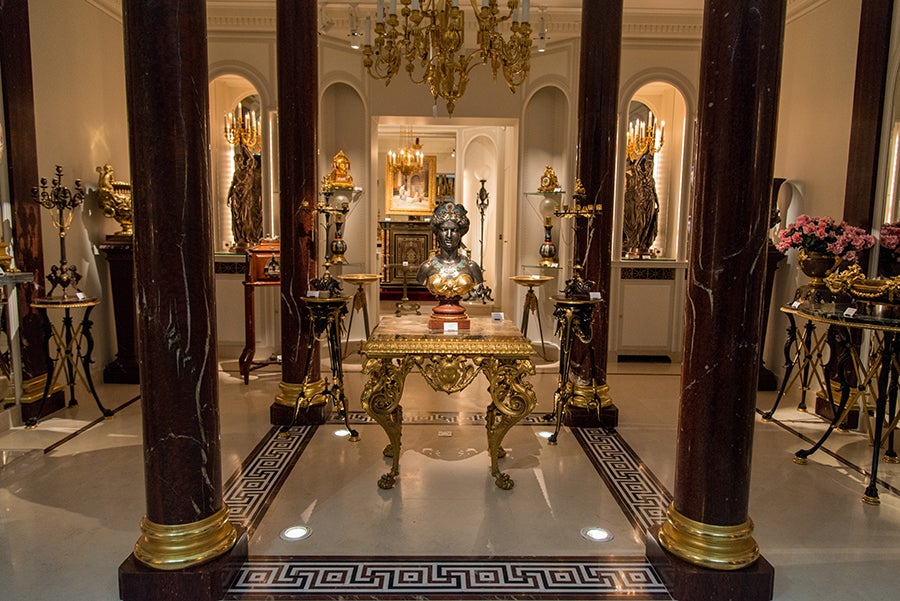
About the Seller
4.9
Vetted Seller
These experienced sellers undergo a comprehensive evaluation by our team of in-house experts.
Established in 1997
1stDibs seller since 2018
76 sales on 1stDibs
Typical response time: <1 hour
Associations
International Confederation of Art and Antique Dealers' Associations
- ShippingRetrieving quote...Ships From: Saint Ouen, France
- Return PolicyA return for this item may be initiated within 7 days of delivery.
More From This SellerView All
- Renaissance Style Wooden Cabinet Attributed to H.A. Fourdinois, France, 1893Located in PARIS, FRA wooden cupboard, elaborately carved throughout, dated "1893" on the crest and attributed to H.A. Fourdinois. The upper section with a pair of cherubs at the center of a balustrade ornamented with two-handled urns, two architectonic doors below, carved with lady and gentleman in niches surrounded by extensive carving with classical motifs. The lower section with two drawers above a standing female caryatid support at each front corner. The all reposing on four gadronned round feet. The Fourdinois company was founded in 1835 by Alexandre-Georges Fourdinois (1799-1871). The Universal Exhibition held in London in 1851 was undoubtedly their first great artistic and public success. Winning the Great medal for a neo-Renaissance buffet...Category
Antique 1890s French Renaissance Cabinets
MaterialsWood
- Renaissance Style Cabinet, France, Circa 1870Located in PARIS, FRAn outstanding carved cabinet in the Renaissance style. The upper part consists in two stages with arcades, divided in six compartments by rich columns with Corinthian capitals, and topped by a carved entablature. The lower part opens with three doors, ornated with masks, hybrid figures and foliates, and relies on four strong feet. This cabinet, probably executed for an amateur or a collector, is a perfect model for the neo-Renaissance style, that rose in the 1830’s, in France with the designers Claude-Aimé Chenavard (1798-1838) and Michel Liénard (1810-1870). It came some years after the Gothic Revival, but met a longer success during the 19th century (at the Expositions des Produits de l’industrie in 1844 and 1849, and at the Universal Exhibitions in 1855, 1867 and 1878). Inspiration was found in the French Renaissance, more specifically in the art of Henri II’s reign, and cabinet-makers used dark carved...Category
Antique 1870s French Renaissance Cabinets
MaterialsWood
- Louis XVI Style Cabinet and its Companion Vitrine by F.Linke, France, Circa 1890By François LinkeLocated in PARIS, FRExceptional Louis XVI style cabinet and its companion vitrine beautifully mounted with chiseled and gilded bronze. They are surmounted by a rectangular top with an egg-and-dart molded edge, above a frieze centered by a laurel-festooned Bacchic mask and scrolling acanthus. The vitrine and the cabinet open by one door ; the paneled door of the cabinet centered by a ribbon-suspended lyre and foliate pendant. Both have the angles adorned with tapering female caryatids, above a guilloche. They rest on tapering fluted quiver-form legs joined by a pierced stretcher, surmounted by a flowery urn, and ending on toupie feet. Related work : Cabinet and vitrine listed under index 684 of Linke’s photographic archives (see photo attached). View of a room of the private collector Elias Meyer’s Mansion, in 16 Grosvenor Square, London, taken in 1909 and reproduced and commented in François Linke (1855-1946), The Belle Epoque of French Furnitures, Ch. Payne, p.247) showing the cabinet and the showcase in situ. (see photo attached). View of the cabinet in situ in the Queen’s bedroom in the Palace Ras al-Tin, in Alexandria, after being bought by King of Egypt Fouad on March 1927. Reproduced and commented in François Linke (1855-1946), The Belle Epoque of French Furnitures, Ch. Payne, p.278. (see photo attached). François Linke, born in 1855 in Bohemia (Czechoslovakia), worked as a cabinet-maker in Paris from about 1882 until his death in 1946. In 1900, at the apex of his career, he opened a new shop at the famous Parisian place Vendôme. He specialized in Louis XV and Louis XVI style furniture: all pieces were beautifully mounted with gilt-bronze ornaments, and he received numerous commissions. Later Linke decided to collaborate with the well-known sculptor Léon Messagé and integrated new lines and shapes announcing the “Art Nouveau” style. His great success is definitely the 1900 Universal Exhibition where he was awarded the gold medal for his extraordinary kingwood desk, designed by Messagé. At this occasion, the “Revue artistique et industrielle” commented that “Linke’s stand...Category
Antique 1890s French Louis XVI Cabinets
MaterialsMarble, Bronze
- Neo-Renaissance Cabinet by P. Sormani and attr. to E. Lièvre, France, Circa 1870By Edouard Lievre, Paul SormaniLocated in PARIS, FRSigned twice on the lock P. SORMANI 10 rue Charlot Paris Rare neo-Renaissance cabinet in carved wood and Portor marble, adorned with chiseled and gilded bronze. The upper, part, surmounted by a frieze of posts and marble cabochons, consists of a central door decorated with a carved panel representing the birth of Venus, framed by two pairs of ringed and fluted columns with Corinthians capitals in gilded bronze revealing two doors with secret opening. Two drawers with lion’s head shaped handles and a central drawer decorated with tracery in gilded bronze complete the upper part of this cabinet. In the lower part, two drawers on the belt with diamond...Category
Antique 1870s French Renaissance Cabinets
MaterialsMarble, Bronze
- Pair of Neo-Renaissance Vitrines, Attributed to H-A Fourdinois, France, c. 1860Located in PARIS, FRFine pair of neo-Renaissance vitrines in richly carved wood, with three glazed sides framed by a relief frieze. Each opening to a drawer decorated with interlacing on the belt, and t...Category
Antique 1860s French Renaissance Revival Vitrines
MaterialsMarble
- Japanese Style Cabinet-Secretary Attributed to G. Viardot, France, Circa 1880By Gabriel ViardotLocated in PARIS, FRA Japanese style carved wood cabinet attributed to G. Viardot. A painted decor imitating Japanese lacquer, ornamented with flowers, birds and butterflies. Opening onto two drawers an...Category
Antique 1880s French Japonisme Cabinets
MaterialsWood, Paint
You May Also Like
- French Renaissance Revival Carved Hunt CabinetLocated in Evergreen, COFine craftsmanship and lavish carvings abound in this handsome Renaissance Revival Hunt cabinet, which was created in France in the late-19th century from European oak. The cabinet i...Category
Antique Late 19th Century French Renaissance Revival Cabinets
MaterialsOak
- Italian Renaissance Revival Table Cabinet by Raphaello Cipriani, circa 1870By Raphaello CiprianiLocated in Brighton, West SussexAn Italian renaissance revival burr yew wood and parcel-gilt painted table cabinet, by Raphaello Cipriani. Italian, circa 1870. The cabinet is inscribed on the back, RAFFAELLO ...Category
Antique Late 19th Century Italian Renaissance Revival Cabinets
MaterialsWood
- 19th Century French Renaissance Confiturier ~ CabinetLocated in Dallas, TX19th Century French Renaissance Confiturier ~ cabinet displays an abundance of artful splendor in a relatively diminutive package! Rendered from old-growth indigenous oak, it feature...Category
Antique 1870s French Renaissance Revival Cabinets
MaterialsOak
- Neo-Renaissance style cabinet with painted enamels signed by Theophile SoyerBy Théophile SoyerLocated in SAINT-OUEN-SUR-SEINE, FRThis two-bodies Neo-Renaissance style display cabinet with two glass doors was made in the second half of the nineteenth century in waxed walnut. The enamel plates, remarkable in the...Category
Antique 19th Century French Renaissance Revival Bookcases
MaterialsEnamel
- 19th Century French Renaissance Two-Tiered CabinetLocated in Dallas, TX19th Century French Renaissance Two-Tiered Cabinet will make a handsome addition to your masculine decor. Hand-crafted from solid oak, it features a ne...Category
Antique 1890s French Renaissance Revival Cabinets
MaterialsBrass
- 19th Century French Renaissance Revival Display CabinetLocated in Tarry Town, NYEarly 19th century French renaissance revival hand carved walnut with marble inserted reserve display wall cabinet. The cabinet is in good antique condition with appropriate wear con...Category
Antique 1810s French Renaissance Revival Cabinets
MaterialsMarble
Recently Viewed
View AllMore Ways To Browse
French Style Cabinets
French Style Cabinet
High Quality Antique Furniture
Carved Wood Cabinet
Antique French Style Cabinet
Four Art Pieces
French Work Cabinet
French Two Piece Cabinet
Antique Furniture Manufacturers
Antique Furniture Manufacturer
Antique Round Cabinet
French Renaissance Style
French Upper Cabinet
Long French Cabinet
1860 French Cabinet
Case Cabinet Signed French
French Sole
1890 Kitchen Cabinet
